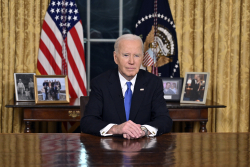Despite bold claims by Russian officials about the T-90M’s superiority, production struggles, battlefield losses, and long-known design flaws undermine its reputation as the world’s best main battle tank.
In recent years, Russian President Vladimir Putin has personally praised the T-90M Proryv-3 main battle tank (MBT), describing it as the best armored vehicle in service today. A recent batch has been delivered to the Russian military, and on the eve of its planned Victory Day celebrations, a Rostec official offered even more hyperbole about the T-90 and other Russian MBTs.
“The Russian T-90M, T-72 B3 M, and T-80 BVM vehicles best suit present-day combat conditions. They can be considered the world’s best serial-produced tanks in terms of their aggregate characteristics. This is the result of the well-coordinated work by the large staff of Rostec enterprises: developers and designers, engineers and technologists, workers of industrial facilities and repair groups,” Vladimir Artyakov, first deputy CEO at the Russian military industrial conglomerate, said in a statement to TASS on Tuesday.
The Rostec chief said the company employs a “flexible system of armor production,” but only offered a few details.
“It has made it possible to ramp up the output of complex vehicles many times over, on the one hand, and ensure prompt alterations in equipment, if required by real conditions, on the other hand,” Artyakov added.
“This adaptive system does not exist anywhere else in the world.”
The T-90M’s Performance “According to Russia”
Anything Russian officials say about production figures needs to be taken with a massive grain of salt. Russia’s production of new vehicles has continued to struggle with losses on the battlefield, which have been significantly higher than what the Kremlin likely expected when it launched its unprovoked invasion of Ukraine more than three years ago.
Moscow has faced deep sanctions that have impacted its ability to source key components for its military platforms, including its tanks. That may explain why reports from Rostec talk of “batches” rather than more specific figures. By keeping this vague, it could be read to be in the dozens or hundreds of new tanks, when in reality, each batch may be just a handful of tanks.
According to a report from the London-based International Institute for Strategic Studies (IISS) last June, production numbers of the T-90 have increased. Yet, Rostec only manufactured around forty before the conflict began, while it may have built seventy in 2023.
Best estimates were that production could exceed ninety this year, but a surge in production could boost those numbers to as high as 200 annually.
Modern tanks are complicated machines and take time to manufacture. It is unlikely Russia could match the output of the famed T-34, with more than 84,000 produced in six years, and certainly could never reach the 100,000+ T-54/55 series tanks produced at the height of the Cold War.
It is also true that the West, including the United States, has far fewer MBTs in service than it did during the Second World War or the Cold War. Putin and Artyakov aren’t the only ones praising the capabilities of modern tanks either. The common belief has been that these modern machines are more effective than past models, but the ongoing conflict in Ukraine has shown that the capabilities to destroy tanks are also better than ever.
The Russian Supply of T-90Ms Can’t Keep Up with Demand
Although production of the T-90 may have ramped up, losses could still outpace production. As of last July, at least 100 Proryv-3 models were reported to have been destroyed, and dozens more are confirmed to have been lost.
Those cold, complex numbers counter the statement that the T-90 is among the best MBTs in service.
The T-90M features a common flaw found in late-era Soviet and early Russian Federation MBTs—namely, it is equipped with an autoloader that can hold more than twenty-two projectiles and charges, with an additional twenty-one rounds in the hull. This allows the tank to maintain a high rate of fire of up to seven or eight rounds per minute and requires just a crew of three.
Yet, if an anti-tank rocket strikes the turret ring, it can set off the rounds inside, creating a deadly chain reaction. The result is the jack-in-the-box effect, where the turret is blown off the chassis. This problem has been far more significant with the T-72 than the newer T-90, but it does affect all Russian MBTS with the autoloader.
As no design changes have been made to address the flaw, such as removing the autoloader, crews in the field have devised ad hoc solutions, including cope cages and turtle armor.
Of course, when Russia has taken the T-90M on the road to foreign arms shows and expos to find international buyers, it hasn’t touted those “aftermarket accessories.”
About the Author: Peter Suciu
Peter Suciu has contributed over 3,200 published pieces to more than four dozen magazines and websites over a thirty-year career in journalism. He regularly writes about military hardware, firearms history, cybersecurity, politics, and international affairs. Peter is also a Contributing Writer for Forbes and Clearance Jobs. He is based in Michigan. You can follow him on Twitter: @PeterSuciu. You can email the author: [email protected].
Image Credit: Shutterstock/ Dmitry Shchukin.
















